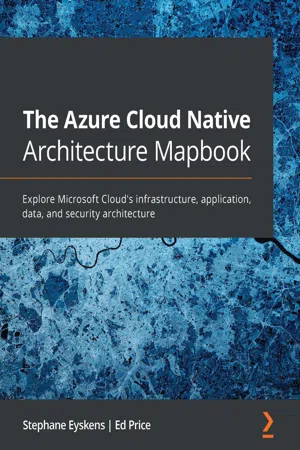
The Azure Cloud Native Architecture Mapbook
Explore Microsoft Cloud's infrastructure, application, data, and security architecture
- 376 pages
- English
- ePUB (mobile friendly)
- Available on iOS & Android
The Azure Cloud Native Architecture Mapbook
Explore Microsoft Cloud's infrastructure, application, data, and security architecture
About this book
Improve your Azure architecture practice and set out on a cloud and cloud-native journey with this Azure cloud native architecture guide
Key Features
- Discover the key drivers of successful Azure architecture
- Implement architecture maps as a compass to tackle any challenge
- Understand architecture maps in detail with the help of practical use cases
Book Description
Azure offers a wide range of services that enable a million ways to architect your solutions. Complete with original maps and expert analysis, this book will help you to explore Azure and choose the best solutions for your unique requirements.
Starting with the key aspects of architecture, this book shows you how to map different architectural perspectives and covers a variety of use cases for each architectural discipline. You'll get acquainted with the basic cloud vocabulary and learn which strategic aspects to consider for a successful cloud journey. As you advance through the chapters, you'll understand technical considerations from the perspective of a solutions architect. You'll then explore infrastructure aspects, such as network, disaster recovery, and high availability, and leverage Infrastructure as Code (IaC) through ARM templates, Bicep, and Terraform. The book also guides you through cloud design patterns, distributed architecture, and ecosystem solutions, such as Dapr, from an application architect's perspective. You'll work with both traditional (ETL and OLAP) and modern data practices (big data and advanced analytics) in the cloud and finally get to grips with cloud native security.
By the end of this book, you'll have picked up best practices and more rounded knowledge of the different architectural perspectives.
What you will learn
- Gain overarching architectural knowledge of the Microsoft Azure cloud platform
- Explore the possibilities of building a full Azure solution by considering different architectural perspectives
- Implement best practices for architecting and deploying Azure infrastructure
- Review different patterns for building a distributed application with ecosystem frameworks and solutions
- Get to grips with cloud-native concepts using containerized workloads
- Work with AKS (Azure Kubernetes Service) and use it with service mesh technologies to design a microservices hosting platform
Who this book is for
This book is for aspiring Azure Architects or anyone who specializes in security, infrastructure, data, and application architecture. If you are a developer or infrastructure engineer looking to enhance your Azure knowledge, you'll find this book useful.
Frequently asked questions
- Essential is ideal for learners and professionals who enjoy exploring a wide range of subjects. Access the Essential Library with 800,000+ trusted titles and best-sellers across business, personal growth, and the humanities. Includes unlimited reading time and Standard Read Aloud voice.
- Complete: Perfect for advanced learners and researchers needing full, unrestricted access. Unlock 1.4M+ books across hundreds of subjects, including academic and specialized titles. The Complete Plan also includes advanced features like Premium Read Aloud and Research Assistant.
Please note we cannot support devices running on iOS 13 and Android 7 or earlier. Learn more about using the app.
Information
Section 1: Solution and Infrastructure
- Chapter 1, Getting Started as an Azure Architect
- Chapter 2, Solution Architecture
- Chapter 3, Infrastructure Design
- Chapter 4, Infrastructure Deployment
Chapter 1: Getting Started as an Azure Architect
- Getting to know architectural duties
- Getting started with the essential cloud vocabulary
- Introducing Azure architecture maps
- Understanding the key factors of a successful cloud journey
Technical requirements
Getting to know architectural duties
Enterprise architects

Domain architects
Solution architects

Data architects


Technical architects
Table of contents
- The Azure Cloud Native Architecture Mapbook
- Contributors
- Preface
- Section 1: Solution and Infrastructure
- Chapter 1: Getting Started as an Azure Architect
- Chapter 2: Solution Architecture
- Chapter 3: Infrastructure Design
- Chapter 4: Infrastructure Deployment
- Section 2: Application Development, Data, and Security
- Chapter 5: Application Architecture
- Chapter 6: Data Architecture
- Chapter 7: Security Architecture
- Section 3: Summary
- Chapter 8: Summary and Industry Scenarios
- Other Books You May Enjoy